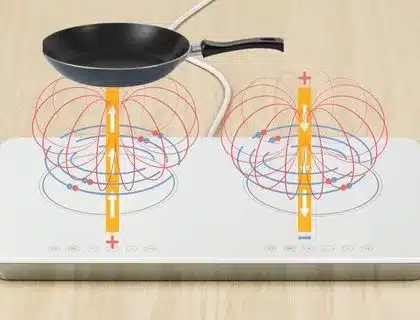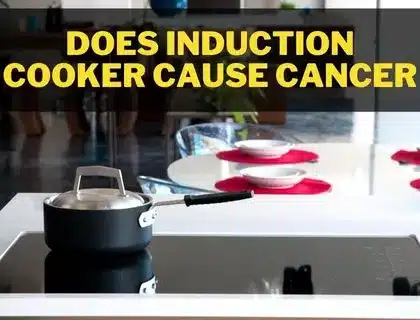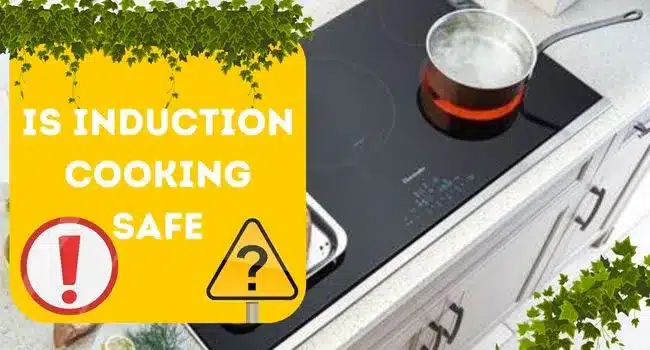Induction cooking has become increasingly popular over the years due to its efficiency, speed, and convenience. Induction cooktops differ from gas and electric ones by using electromagnetic fields to generate heat directly in the cookware. It allows for faster and more precise cooking. However, while induction cooktops offer many benefits, it is imperative to understand their safety features and potential health hazards.
Table of Contents
Is Induction Cooking Safe?
In this article, we will explore the safety of induction cooktops, the potential health hazards associated with induction cooking, and the preventive measures to take when using induction cooktops. By the end of this article, you will better understand how to use induction cooktops safely and avoid potential risks.
We will examine the safety of induction cooktops from different perspectives, including cooking safety, user safety, and the potential risks associated with magnetic radiation. Firstly, we will explore the safety of induction cooking itself.
Induction cooktops have several safety features that make them safe for cooking. Induction cooktops only generate heat when cookware is on the surface, and they turn off automatically when no cookware is detected. Additionally, the cooktop’s surface does not get hot, reducing the risk of accidental burns.
On the other hand, gas and electric cooktops carry the risk of gas leaks, flames, and hot coils, which can cause fires and burns. The National Fire Protection Association states that cooking equipment is the primary cause of home fires and fire injuries in the US. Induction cooktops can help reduce this risk.
Induction cooktops have been found to be safer than gas and electric cooktops when compared to other cooking methods. A Consumer Product Safety Commission study found that induction cooktops have a lower risk of causing fires or burns than electric and gas cooktops.
Do Induction Cooktops emit Strong EMF?
I came across a controversy around the potential dangers of the magnetic radiation generated by induction cooktops, an article by Sarah Pope on her website. A study published in the Journal Bioelectromagnetic found that most induction cooktops exceeded the maximum exposure levels set by the International Commission on Non-Ionizing Radiation Protection (ICNIRP), with the worst-case scenario showing a 16-fold increase in exposure levels.
The article’s author referred to safety tests by “Powerwatch,” which assumed that a person would always be at least 1 foot (30 cm) away from the front of the induction stove.
However, it is difficult to maintain such a distance while cooking, especially when using the back burners. This raises concerns about the potential risks of exposure to the magnetic radiation generated by the cooktops, especially for those who spend more time in close proximity to them.
How Much is emf harmful in induction cooking?
The level of potential harm from EMF exposure in induction cooking is a topic of debate and requires further research. While some studies have suggested potential risks associated with exposure to high levels of EMF radiation, others have found no evidence of harm from using induction cooktops. As with any technology that emits radiation, it is important to follow safety guidelines and minimize exposure as much as possible.
Therefore, I conducted further research on EMF radiation to determine the extent of its potential harm.
In the process, I came across another article that discusses the topic in more detail.
According to the article, it is generally considered safe to use induction stoves, as the EMFs they produce are non-ionizing and do not cause direct harm to DNA or cells.
Health Hazards of Induction Cooking
Induction cooktops are generally safe, but there are some health hazards.
Electromagnetic Radiation
One concern is the electromagnetic radiation that is emitted by the cooktop. While the radiation levels emitted by induction cooktops are generally low, some people may be more sensitive to it than others. People with pacemakers or other medical devices should consult their doctor before using an induction cooktop.
Type of Cookware
Another potential health hazard is the cookware used on the induction cooktop. Induction cooktops require cookware made of magnetic materials, such as cast iron or stainless steel, to work. Cookware made of non-magnetic materials, such as copper or glass, will not be compatible with induction cooktops. Additionally, some cookware may leach chemicals into the food when heated, harming health.
Proper ventilation is also important when cooking with induction cooktops. While the cooktop does not emit harmful fumes, cooking can produce smoke and other airborne particles that can harm health if not properly ventilated.
Cautionary Measures When Using Induction Cooktops
To use induction cooktops safely, taking some precautionary steps is crucial. Here are some tips to keep in mind:
- Always use cookware made of magnetic materials compatible with the induction cooktop.
- Maintain a safe distance from induction cooktops while they are in operation to ensure maximum safety.
- Keep the cooktop surface clean and free of any debris that may interfere with the electromagnetic field.
- Avoid dragging heavy pots or pans across the cooktop surface, as this can scratch or damage the surface.
- Ensure the cookware is centred on the cooktop surface to ensure even heating.
- Before using the induction cooktop, it’s important to read and follow the manufacturer’s instructions and guidelines carefully.
Disadvantages of Induction Cooking
We have listed some downsides of induction cookers:
Compatibility with Cookware:
Induction cooktops require specific types of cookware compatible with the magnetic fields they generate. It means that not all types of cookware can be used on an induction cooktop, and users may need to purchase new cookware to use with the appliance.
Higher Cost:
Due to their advanced technology, induction cooktops may have higher prices than traditional gas or electric ones, limiting accessibility for some consumers.
Noise:
Some users have reported that induction cooktops can be louder than others, which generates a slight humming or buzzing sound.
Power Requirements:
Induction cooktops require a certain amount of power to operate, which may require users to upgrade their electrical systems or modify their kitchens.
Learning Curve:
Induction cooking may require a learning curve, as users may need to adjust to the appliance’s different cooking times and temperatures.
Susceptibility to Scratches:
Induction cooktops can be susceptible to scratches and other damage, which can be costly to repair or replace.
Safety Concerns:
While induction cooking is generally considered safe, a few potential safety concerns are associated with the appliance, such as the risk of injury from hot cookware or improper cooktop use. Users must follow proper precautions and use the appliance according to the manufacturer’s instructions to minimize potential risks.
FAQs:
Does Induction Cooker Cause Cancer?
No definitive proof indicates that induction cookers are linked to cancer. Induction cookers generate an electromagnetic field when used, which has led to concerns about whether prolonged exposure to these fields can increase cancer risk.
However, according to the National Cancer Institute, there is currently no convincing evidence that exposure to electromagnetic fields from induction cookers or other household appliances increases the risk of cancer in humans.
In fact, some studies have suggested that induction cooking may be safer than traditional gas or electric cooktops, as it produces fewer harmful emissions and pollutants associated with increased cancer risk.
That said, it is important to use induction cookers properly and according to the manufacturer’s instructions and to exercise caution when handling hot or incompatible cookware. By taking these precautions, users can safely enjoy the benefits of induction cooking without putting themselves at risk for cancer or other health issues.
Is induction cooking safe during pregnancy?
Pregnant women may also want to be cautious about exposure to electromagnetic fields, as some studies have suggested that prolonged exposure to high levels of electromagnetic radiation may have negative health effects. However, the levels of electromagnetic radiation generated by induction cooktops are generally considered safe for most people, including pregnant women.
Electromagnetic waves from induction cooktops can extend beyond the immediate area and reach a few feet, which can be concerning for pregnant women as they may unintentionally expose themselves and their developing fetuses to this type of radiation.
Suppose you are pregnant and have concerns about using an induction cooktop. In that case, it may be helpful to speak with your healthcare provider or a qualified professional to understand better potential risks and how to minimize them.
Induction cooking is considered safe during pregnancy, but following food safety guidelines and taking necessary precautions to prevent foodborne illness is crucial.
Is induction cooking safe for pacemakers?
Individuals with pacemakers may be concerned about the potential electromagnetic interference (EMI) generated by induction cooktops.
Pacemakers are electronic devices that control the electrical activity of the heart. Induction hobs produce strong electromagnetic fields that can interfere with pacemakers. For safety reasons, it’s important to maintain a distance of approximately two feet between the pacemaker and the cooktop.
Suppose you have a pacemaker and are concerned about the potential EMI from an induction cooktop. In that case, it is recommended to consult with your healthcare provider or the pacemaker manufacturer for specific guidelines and recommendations. They can provide you with specific information regarding the compatibility of your pacemaker with induction cooktops and how to minimize any potential risks.
Is induction cooking harmful to health?
Induction cooking is generally considered safe and poses no significant health risks. In fact, some studies have suggested that induction cooking may be safer than traditional gas or electric cooktops, as it produces fewer harmful emissions and pollutants associated with increased health risks.
Despite its benefits, some potential concerns associated with induction cooking exist that users should be aware of. For example, individuals with certain medical devices or conditions may be more susceptible to harm from the electromagnetic fields generated by induction cooktops. Additionally, using non-compatible cookware or improperly handling hot cookware can pose a risk of injury.
To minimize any potential risks associated with induction cooking, following proper precautions and using the cooktop according to the manufacturer’s instructions is important. It may include using compatible cookware, avoiding touching hot surfaces or cookware, and ensuring that the cooktop is installed correctly and maintained.
Overall, while there are some potential risks associated with induction cooking, it is generally considered a safe and healthy cooking method that can offer many benefits, such as faster cooking times, energy efficiency, and improved air quality in the kitchen.
Conclusion:
In general, induction cooking is considered a safe and efficient method of cooking that provides several advantages over conventional gas or electric cooktops. With proper precautions and care, induction cooking can address potential concerns, such as compatibility with cookware and higher costs.
Studies have also suggested that induction cooking may be safer and healthier than other cooktops, producing fewer harmful emissions and pollutants. As with any appliance, users must follow proper precautions and use the cooktop according to the manufacturer’s instructions to minimize potential risks. With proper care and attention, induction cooking can offer a safe and healthy meal preparation.
